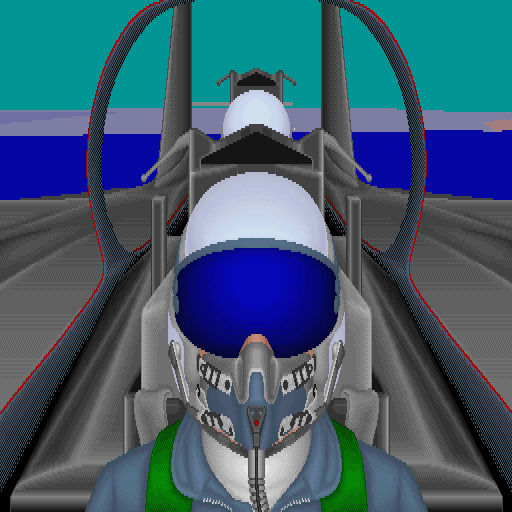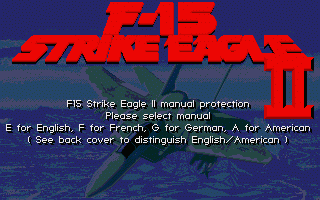Retro Replay Review
Gameplay
F-15 Strike Eagle II places you in the pilot’s seat of the iconic F-15 Eagle with an expansive set of campaigns stretching across Libya, the Persian Gulf, the Middle East, and Vietnam. Each theater offers unique mission parameters, from high-speed interceptions over desert landscapes to precision strikes in dense jungle corridors. With over 250,000 miles of potential action, you’ll face a relentless procession of primary and secondary targets—from enemy fighters and bombers to SAM sites and hardened ground installations. The strategic depth lies in deciding which targets to prioritize: disabling a radar site might reduce incoming missiles, but taking out armor columns can be critical for allied ground forces.
(HEY YOU!! We hope you enjoy! We try not to run ads. So basically, this is a very expensive hobby running this site. Please consider joining us for updates, forums, and more. Network w/ us to make some cash or friends while retro gaming, and you can win some free retro games for posting. Okay, carry on 👍)
The control scheme balances authenticity and accessibility. You have a cannon for close encounters, AMRAAMs for beyond-visual-range engagements, Sidewinder missiles for dogfighting, and Maverick air-to-ground weapons for pinpoint strikes. A responsive AI ensures that enemy pilots evade, flank, and counterattack in real time. Thankfully, an integrated targeting computer helps you lock on quickly, so you can stay focused on maneuvering rather than wrestling with aiming. Eleven camera angles, including internal cockpit views and chase-cams, let you appreciate every split-second of combat or zoom out for tactical situational awareness.
For newcomers, the training mode provides a gentle learning curve. You can disable crashes, automate takeoffs and landings, and practice individual skills in isolated exercises. Meanwhile, two “Director’s Modes” dynamically cut away from your view to highlight significant battlefield moments—watch SAM sites spring to life, witness your missiles arcing toward their targets, or observe enemy fighters scrambling from a hidden base. These features not only add cinematic flair but also keep you informed of the larger operational picture, ensuring that no critical event slips by unnoticed.
Graphics
Released in the early ’90s, F-15 Strike Eagle II’s graphics hold up remarkably well for their era. Terrain is rendered with simple but effective flat-shaded polygons and a palette that distinguishes sand, sea, and vegetation across different theaters. Although you won’t find photo-realistic textures, the minimalistic art style results in a clear, uncluttered display—vital when you’re speeding toward a target at Mach 2. Cockpit instruments are crisp and legible, with distinct gauges for altitude, speed, and radar lock status.
The eleven camera angles are a standout graphical feature that enhances immersion. An internal cockpit view offers an authentic pilot’s perspective, complete with a detailed control panel and HUD overlays. External views let you admire the Eagle’s sleek airframe as missile trails blaze behind or watch enemy jets break apart in fiery explosions. Even with limited color depth, the combination of dynamic camera cuts and smooth animation delivers a sense of high-speed action rarely matched by contemporaries.
Special effects such as smoke trails, missile contrails, and occasional puff clouds from cannon fire may look dated by modern standards, but they effectively convey kinetic energy and impact. Ground features like roads, buildings, and SAM installations are represented with blocky geometry, yet remain distinct enough to identify mission-critical structures. When your Maverick closes in on an armor column or your AMRAAM finds its target in the sky, the resulting detonation animations provide satisfying visual feedback that underscores the potency of your weapons loadout.
Story
F-15 Strike Eagle II doesn’t rely on a traditional narrative or character arcs; instead, its storytelling emerges from the geopolitical crises that frame each campaign. Mission briefings deliver concise yet evocative context—whether you’re enforcing no-fly zones over Libya, safeguarding oil shipping lanes in the Persian Gulf, or conducting interdiction runs in a war-torn Vietnamese valley. These scenarios tap into real-world tensions of the late Cold War and post-Cold War era, delivering a palpable sense of urgency and consequence.
While there are no named wingmen or scripted cutscenes beyond the Director’s Modes, the game cultivates its own drama through replayable mission designs. Every sortie is a potential nail-biter: one missed SAM site can end the mission prematurely, and enemy fighters may swarm your wing like hornets if you linger too long near a hostile airfield. Briefing debriefings reinforce the stakes by tallying primary and secondary target outcomes, encouraging you to refine your tactics and replay missions for better results.
Without a traditional plotline, F-15 Strike Eagle II places narrative ownership in your hands. As you log flight hours and earn commendations for mission successes, you build your own pilot’s legend. Whether you’re proud of a flawless bombing run in a dense jungle or a last-second missile lock in a fast-paced dogfight, those self-made triumphs carry more weight than any scripted storyline—fueling your desire to conquer every inch of that 250,000-mile battleground.
Overall Experience
F-15 Strike Eagle II stands as a testament to the enduring appeal of accessible yet deep flight simulation. Its mission variety and geostrategic breadth keep you engaged for hours, while the mixture of air-to-air and air-to-ground combat ensures no two sorties feel identical. The training modes and targeting assistance strike a balanced path between hardcore simulation and pick-up-and-play action, making it an excellent choice for both sim veterans and curious newcomers.
The audiovisual package may not compete with modern flight sims’ photorealism and surround sound bombast, but its streamlined presentation serves gameplay superbly. Fast load times, responsive controls, and a well-organized mission planner mean you spend less time fiddling with setup screens and more time in the cockpit. The Director’s Modes add a cinematic flourish, turning every missile launch or SAM volley into a moment you’ll instantly remember—and perhaps even screenshot for bragging rights.
Ultimately, F-15 Strike Eagle II offers a rewarding balance of challenge and approachability. Its focus on mission-driven engagement rather than lengthy narratives ensures that the action is always front and center. If you’re seeking a classic combat flight experience that delivers strategic depth, varied theaters of operation, and the thrill of air superiority and precision strikes—backed by a rich legacy of arcade-style accessibility—this eagle will still soar high in your hangar.
 Retro Replay Retro Replay gaming reviews, news, emulation, geek stuff and more!
Retro Replay Retro Replay gaming reviews, news, emulation, geek stuff and more!









Reviews
There are no reviews yet.